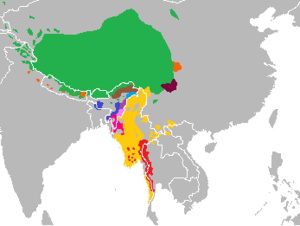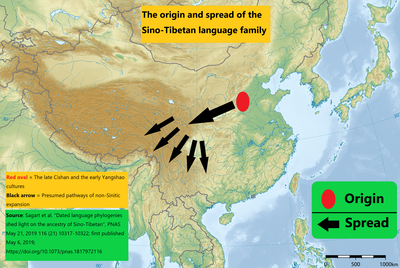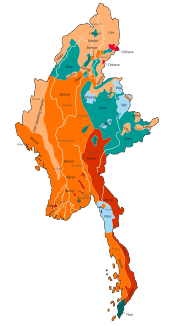Tibeto-Burman languages
| Tibeto-Burman | |
|---|---|
| Geographic distribution | Southeast Asia, East Asia, South Asia |
| Linguistic classification | Sino-Tibetan
|
| Proto-language | Proto-Tibeto-Burman |
| Subdivisions | |
| ISO 639-5 | tbq |
| Glottolog | None |
 | |
The Tibeto-Burman languages are the non-Sinitic members of the Sino-Tibetan language family, over 400 of which are spoken throughout the Southeast Asian Massif ("Zomia") as well as parts of East Asia and South Asia. Around 60 million people speak Tibeto-Burman languages.[1] The name derives from the most widely spoken of these languages, Burmese and the Tibetic languages, which also have extensive literary traditions, dating from the 12th and 7th centuries respectively. Most of the other languages are spoken by much smaller communities, and many of them have not been described in detail.
Though the division of Sino-Tibetan into Sinitic and Tibeto-Burman branches (e.g. Benedict, Matisoff) is widely used, some
History

During the 18th century, several scholars noticed parallels between Tibetan and Burmese, both languages with extensive literary traditions. In the following century, Brian Houghton Hodgson collected a wealth of data on the non-literary languages of the Himalayas and northeast India, noting that many of these were related to Tibetan and Burmese.[7] Others identified related languages in the highlands of Southeast Asia and south-west China. The name "Tibeto-Burman" was first applied to this group in 1856 by
Charles Forbes viewed the family as uniting the Gangetic and Lohitic branches of Max Müller's Turanian, a huge family consisting of all the Eurasian languages except the Semitic, "Aryan" (Indo-European) and Chinese languages.[10] The third volume of theJulius Klaproth had noted in 1823 that Burmese, Tibetan and Chinese all shared common basic vocabulary, but that Thai, Mon and Vietnamese were quite different.[11] Several authors, including Ernst Kuhn in 1883 and August Conrady in 1896, described an "Indo-Chinese" family consisting of two branches, Tibeto-Burman and Chinese-Siamese.[12] The Tai languages were included on the basis of vocabulary and typological features shared with Chinese. Jean Przyluski introduced the term sino-tibétain (Sino-Tibetan) as the title of his chapter on the group in Antoine Meillet and Marcel Cohen's Les Langues du Monde in 1924.[13]
The Tai languages have not been included in most Western accounts of Sino-Tibetan since the Second World War, though many Chinese linguists still include them. The link between Tibeto-Burman and Chinese is now accepted by most linguists, with a few exceptions such as Roy Andrew Miller and Christopher Beckwith.[14][15][16] More recent controversy has centred on the proposed primary branching of Sino-Tibetan into Chinese and Tibeto-Burman subgroups. In spite of the popularity of this classification, first proposed by Kuhn and Conrady, and also promoted by Paul Benedict (1972) and later James Matisoff, Tibeto-Burman has not been demonstrated to be a valid subgroup in its own right.[3]
Overview
Most of the Tibeto-Burman languages are spoken in remote mountain areas, which has hampered their study. Many lack a written standard. It is generally easier to identify a language as Tibeto-Burman than to determine its precise relationship with other languages of the group.[17] The subgroupings that have been established with certainty number several dozen, ranging from well-studied groups of dozens of languages with millions of speakers to several isolates, some only discovered in the 21st century but in danger of extinction.[18] These subgroups are here surveyed on a geographical basis.
Southeast Asia and southwest China

The southernmost group is the
The most widely spoken Tibeto-Burman language is

The Tibeto-Burman languages of south-west China have been heavily influenced by Chinese over a long period, leaving their affiliations difficult to determine. The grouping of the
Two historical languages are believed to be Tibeto-Burman, but their precise affiliation is uncertain. The
Tibet and South Asia

Over eight million people in the Tibetan Plateau and neighbouring areas in Baltistan, Ladakh, Nepal, Sikkim and Bhutan speak one of several related Tibetic languages. There is an extensive literature in Classical Tibetan dating from the 8th century. The Tibetic languages are usually grouped with the smaller East Bodish languages of Bhutan and Arunachal Pradesh as the Bodish group.
Many diverse Tibeto-Burman languages are spoken on the southern slopes of the Himalayas. Sizable groups that have been identified are the West Himalayish languages of Himachal Pradesh and western Nepal, the Tamangic languages of western Nepal, including Tamang with one million speakers, and the Kiranti languages of eastern Nepal. The remaining groups are small, with several isolates. The Newar language (Nepal Bhasa) of central Nepal has a million speakers and literature dating from the 12th century, and nearly a million people speak Magaric languages, but the rest have small speech communities. Other isolates and small groups in Nepal are
The Tani languages include most of the Tibeto-Burman languages of Arunachal Pradesh and adjacent areas of Tibet.[25] The remaining languages of Arunachal Pradesh are much more diverse, belonging to the small
These groups have relatively little Tibeto-Burman vocabulary, and Bench and Post dispute their inclusion in Sino-Tibetan.[27]The greatest variety of languages and subgroups is found in the highlands stretching from northern Myanmar to northeast India.
Northern Myanmar is home to the small
The border highlands of
The Mru language is spoken by a small group in the Chittagong Hill Tracts between Bangladesh and Myanmar.[30][31]
Classification
There have been two milestones in the classification of Sino-Tibetan and Tibeto-Burman languages, Shafer (1955) and Benedict (1972), which were actually produced in the 1930s and 1940s respectively.
Shafer (1955)
Shafer's tentative classification took an agnostic position and did not recognize Tibeto-Burman, but placed Chinese (Sinitic) on the same level as the other branches of a Sino-Tibetan family.[32] He retained Tai–Kadai (Daic) within the family, allegedly at the insistence of colleagues, despite his personal belief that they were not related.
- Sino-Tibetan
- Sinitic
- ?? Daic
- Bodic
- Bodish (Gyarong, Tibetic)
- West Himalayish (incl. Thangmi, Baram, Raji–Raute)
- West Central Himalayish (Hayu[misplaced])
- East Himalayish
- Newarish
- Digarish
- Midźuish
- Hruish
- Dhimalish
- Miśingish
- Dzorgaish
- Bodish (
- Burmic
- Baric
- Barish
- Nagish
- Karenic
Benedict (1972)
A very influential, although also tentative, classification is that of Benedict (1972), which was actually written around 1941. Like Shafer's work, this drew on the data assembled by the Sino-Tibetan Philology Project, which was directed by Shafer and Benedict in turn. Benedict envisaged Chinese as the first family to branch off, followed by Karen.
- Sino-Tibetan
- Chinese
- Tibeto-Karen
- Karen
- Tibeto-Burman
The Tibeto-Burman family is then divided into seven primary branches:
- Tibeto-Burman
- Tibetan–Kanauri (a.k.a. Bodish–Himalayish)
- Bodish
- ()
- Himalayish
- "major" Himalayish
- "minor" Himalayish
- (Rangkas, Darmiya, Chaudangsi, Byangsi)
- (perhaps also Dzorgai, Lepcha, Magari)
- Bodish
- Bahing–Vayu
- Abor–Miri–Dafla
- (perhaps also Dhimal)
- (perhaps also
- Kachin
- (perhaps including Luish)
- (perhaps including
- Burmese–Lolo
- Boro-Garo
- Boro
- Garo (A·chik)
- Tripuri (Kokborok)
- Dimasa
- Mech
- Rava (Koch)
- Tiwa (Lalung)
- Sutiya
- Saraniya
- Sonowal
- Thengal
- (Perhaps also "Naked Naga" a.k.a. Konyak)
- Kuki–Naga(a.k.a. Kukish)
- (perhaps also Meithei, Mru)
- (perhaps also
- Tibetan–Kanauri (a.k.a. Bodish–Himalayish)
Matisoff (1978)
- Sino-Tibetan
- Chinese
- Tibeto-Burman
Tibeto-Burman is then divided into several branches, some of them geographic conveniences rather than linguistic proposals:
- Tibeto-Burman
- Kamarupan (geographic)
- Kuki-Chin–Naga (geographic)
- Abor–Miri–Dafla
- Boro–Garo
- Himalayish(geographic)
- Mahakiranti (includes Newar, Magar, Kiranti)
- Tibeto-Kanauri (includes Lepcha)
- Qiangic
- Jingpho–Nungish–Luish
- Jingpho
- Nungish
- Luish
- Naxi
- Karenic
- Baic
- Tujia (unclassified)
- Kamarupan (geographic)
Matisoff makes no claim that the families in the Kamarupan or Himalayish branches have a special relationship to one another other than a geographic one. They are intended rather as categories of convenience pending more detailed comparative work.
Matisoff also notes that Jingpho–Nungish–Luish is central to the family in that it contains features of many of the other branches, and is also located around the center of the Tibeto-Burman-speaking area.
Bradley (2002)
Since Benedict (1972), many languages previously inadequately documented have received more attention with the publication of new grammars, dictionaries, and wordlists. This new research has greatly benefited comparative work, and Bradley (2002) incorporates much of the newer data.[34]
van Driem
George van Driem rejects the primary split of Sinitic, making Tibeto-Burman synonymous with Sino-Tibetan.
Matisoff (2015)
The internal structure of Tibeto-Burman is tentatively classified as follows by
Other languages
The classification of
Randy LaPolla (2003) proposed a Rung branch of Tibeto-Burman, based on morphological evidence, but this is not widely accepted.
Scott DeLancey (2015)[37] proposed a Central branch of Tibeto-Burman based on morphological evidence.
Roger Blench and Mark Post (2011) list a number of divergent languages of Arunachal Pradesh, in northeastern India, that might have non-Tibeto-Burman substrates, or could even be non-Tibeto-Burman language isolates:[27]
Blench and Post believe the remaining languages with these substratal characteristics are more clearly Sino-Tibetan:
- East Bodish
- Meyor (Zakhring)
- Tawang District
- Monpa of Kalaktang (Tshangla)
- Monpa of Zemithang
- Monpa of Mago-Thingbu
- Tani: Nah
- East Bodish
Notes
- ^ Source: United States Central Intelligence Agency, 1983. The map shows the distribution of ethnolinguistic groups according to the historical majority ethnic groups by region. Note this is different from the current distribution due to ongoing internal migration and assimilation.
References
Notes
- ^ Eberhard, David M.; Simons, Gary F.; Fennig, Charles D., eds. (2019). Ethnologue: Languages of the World (22nd ed.). Dallas, Texas: SIL International.
- ^ Guillaume, Jacques (2012). "The Tangut Kinship System in Qiangic Perspective". In Hill, Nathan (ed.). Medieval Tibeto-Burman Languages IV. p. 215.
- ^ a b Handel (2008), p. 431.
- ^ Guillaume, Jacques (2007). "A shared suppletive pattern in the pronominal systems of Chang Naga and Southern Qiang". Cahiers de Linguistique Asie Orientale. 36 (1): 2.
- ^ DeLancey, Scott (2013). "The origins of Sinitic". In Zhuo, Jing-Schmidt (ed.). Increased Empiricism: Recent advances in Chinese Linguistics. John Benjamins. p. 74.
- ^ Sagart et al. (2019), p. 10319–10320.
- ^ Hodgson (1853).
- ^ Logan (1856).
- ^ Logan (1858).
- ^ Forbes (1878).
- ^ van Driem (2001), p. 334.
- ^ van Driem (2001), pp. 341–342.
- ^ Sapir (1925).
- ^ Miller (1974).
- ^ Beckwith (1996).
- ^ Beckwith (2002).
- ^ Handel (2008), pp. 424–432.
- ^ a b van Driem (2011a).
- ^ Thurgood (2003), p. 18.
- ^ Thurgood (2003), pp. 8–9.
- ^ Coblin (1979).
- ^ Thurgood (2003), p. 20.
- ^ Thurgood (2003), pp. 17, 19–20.
- ^ van Driem (2007), p. 296.
- ^ Burling (2003), pp. 178, 180–181.
- ^ Burling (2003), pp. 178–182.
- ^ a b Blench & Post (2011).
- ^ Thurgood (2003), pp. 11–12.
- ^ Burling (2003), pp. 174–178.
- ^ Thurgood (2003), pp. 12–14.
- ^ Burling (2003), pp. 182–189.
- ^ Shafer (1955).
- ^ Namkung (1996), p. 455.
- ^ Bradley (2002).
- ^ Matisoff, James A. 2015. The Sino-Tibetan Etymological Dictionary and Thesaurus. Berkeley: University of California. (PDF)
- doi:10.6078/D1159Q
Bibliography
- Beckwith, Christopher I. (1996), "The Morphological Argument for the Existence of Sino-Tibetan", Pan-Asiatic Linguistics: Proceedings of the Fourth International Symposium on Languages and Linguistics, January 8–10, 1996, Bangkok: Mahidol University at Salaya, pp. 812–826.
- ——— (2002), "The Sino-Tibetan problem", in Beckwith, Chris; Blezer, Henk (eds.), Medieval Tibeto-Burman languages, BRILL, pp. 113–158, ISBN 978-90-04-12424-0.
- ISBN 978-0-521-08175-7.
- Bielmeier, Roland; Haller, Felix, eds. (2007), Linguistics of the Himalayas and Beyond, Berlin and New York: Mouton de Gruyter, ISBN 978-3-11-019828-7.
- Blench, Roger; Post, Mark (2011), (De)classifying Arunachal languages: Reconsidering the evidence (PDF), archived from the original (PDF) on 2013-05-26.
- ———; ——— (2013), "Rethinking Sino-Tibetan phylogeny from the perspective of North East Indian languages", in Hill, Nathan W.; Owen-Smith, Thomas (eds.), Trans-Himalayan Linguistics, Berlin: Mouton de Gruyter, pp. 71–104, ISBN 978-3-11-031083-2.
- ISBN 978-0-85883-456-9.
- ——— (2002), "The Subgrouping of Tibeto-Burman", in Beckwith, Chris; Blezer, Henk (eds.), Medieval Tibeto-Burman languages, BRILL, pp. 73–112, ISBN 978-90-04-12424-0.
- ISBN 978-0-7007-1129-1.
- Coblin, W. South (1979), "A New Study of the Pai-lang Songs"(PDF), Tsing Hua Journal of Chinese Studies, 12: 179–216.
- ISBN 978-90-04-12062-4.
- ——— (2003), "Tibeto-Burman Phylogeny and Prehistory: Languages, Material Culture and Genes", in Bellwood, Peter; Renfrew, Colin (eds.), Examining the farming/language dispersal hypothesis, pp. 233–249, ISBN 978-1-902937-20-5.
- ——— (2007), "South Asia and the Middle East", in Moseley, Christopher (ed.), Encyclopedia of the World's Endangered Languages, Routledge, pp. 283–347, ISBN 978-0-7007-1197-0.
- ——— (2011a), "Tibeto-Burman subgroups and historical grammar", Himalayan Linguistics Journal, 10 (1): 31–39, archived from the original on 2012-01-12.
- Forbes, Charles James (1878), "On Tibeto-Burman languages", S2CID 163329316.
- Handel, Zev (2008), "What is Sino-Tibetan? Snapshot of a Field and a Language Family in Flux", Language and Linguistics Compass, 2 (3): 422–441, .
- Hodgson, Brian Houghton (1853), "On the Indo-Chinese Borderers and their connexion with the Himálayans and Tibetans", Journal of the Asiatic Society of Bengal, 22 (1): 1–25.
- Logan, James R. (1856), "The Maruwi of the Baniak Islands", Journal of the Indian Archipelago and Eastern Asia, 1 (1): 1–42.
- ——— (1858), "The West-Himalaic or Tibetan tribes of Asam, Burma and Pegu", Journal of the Indian Archipelago and Eastern Asia, 2 (1): 68–114.
- JSTOR 600891.
- Namkung, Ju, ed. (1996), Phonological Inventories of Tibeto-Burman Languages (PDF), STEDT Monograph, vol. 3, University of California, Berkeley, ISBN 0-944613-28-4.
- JSTOR 2914102.
- Shafer, Robert (1955), "Classification of the Sino-Tibetan languages", Word (Journal of the Linguistic Circle of New York), 11 (1): 94–111, .
- ——— (1966), Introduction to Sino-Tibetan (Part 1), Wiesbaden: Otto Harrassowitz.
- ——— (1967), Introduction to Sino-Tibetan (Part 2), Wiesbaden: Otto Harrassowitz.
- ——— (1968), Introduction to Sino-Tibetan (Part 3), Wiesbaden: Otto Harrassowitz.
- ——— (1970), Introduction to Sino-Tibetan (Part 4), Wiesbaden: Otto Harrassowitz, ISBN 978-3-447-01286-7.
- ——— (1974), Introduction to Sino-Tibetan (Part 5), Wiesbaden: Otto Harrassowitz, ISBN 978-3-447-01559-2.
- ISBN 978-0-7007-1129-1.
- PMID 31061123.
- "Origin of Sino-Tibetan language family revealed by new research". ScienceDaily (Press release). May 6, 2019.
Further reading
- Mann, Noel Walter (1998). A phonological reconstruction of Proto Northern Burmic. Unpublished thesis. Arlington: The University of Texas.
- Konow, Sten (1911). . In Chisholm, Hugh (ed.). Encyclopædia Britannica. Vol. 26 (11th ed.). Cambridge University Press. pp. 928–929.

